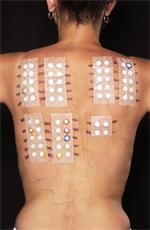 Patch Testing Patch Testing
Who may benefit from a patch test to exclude skin allergy?
Patch testing is a way of finding allergies to chemicals/materials that come in contact with your skin during daily activities at home, work, hobbies or other recreational activities. Many substances can be tested and need to be carefully chosen with relevance to your hobbies and job. Atopic eczema (linked with asthma and hayfever), hand dermatitis, facial, eyelid, leg or foot dermatitis sufferers can all benefit from investigation with a patch test. In addition, any other unusual site or persistent generalized dermatitis or eczema not improving with treatments such as steroid ointments or moisturizing creams may mean a skin allergy has developed. What does a patch test involve? Three visits are involved in the same week with suspected chemicals/materials applied on your back and covered with adhesive tape on Monday. The skin on the back is then marked with special ink to identify each chemical after the tape is removed on Wednesday. The final reading is on Friday and the results will be explained at this visit with full written information. What does the patch test detect? This test detects skin allergy to substances such as cosmetics, hair dyes, leather, rubber, metals, perfumes and preservatives. This type of allergic reaction follows contact with the causative substance and delayed reactions can occur after 2-7 days. This means very often it is impossible to know retrospectively what caused the flare up of your eczema or dermatitis. Recent examples of skin problems investigated with patch testing include methylisothiazolinone (MI) preservative allergy, perfume allergy to limonene/linalool, leather sofa reactions and black hair allergy. Severe blistering reactions can occur if you are highly allergic to any of the substances tested such as hair dyes (see below).  Patch testing is NOT useful for food allergies or itchy hives which are investigated with blood tests or skin prick testing. Patch testing is NOT useful for food allergies or itchy hives which are investigated with blood tests or skin prick testing.
Click here to download our full information sheet |
